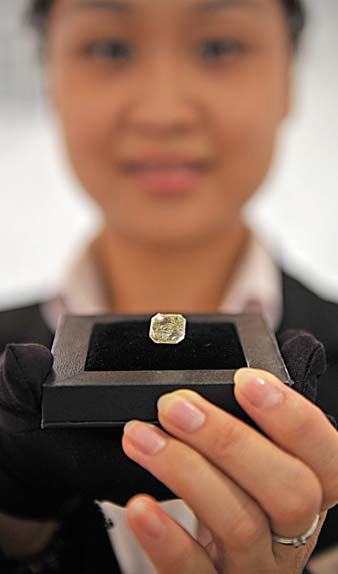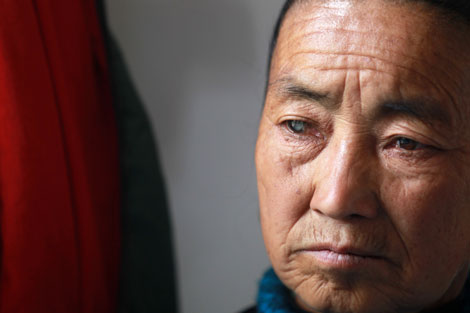Beauty is now on the screen of the beholder
Updated: 2011-11-18 08:53
By Lu Chang (China Daily)
|
|||||||||
|
To have direct contact with diamonds, customers can go to online retailers' experience stores. Provided to China Daily |
Online jewelers give shops with windows a run for their money
Any serious diamond shopper can rattle off the four c's: cut, clarity, color and carat weight. This evaluation helps determine the worth of a diamond.
But the process of evaluating where to buy the precious stone is evolving as more consumers move from traditional brick-and-mortar retail sites to online avenues.
Figures from the Gems and Jewelry Trade Association of China show that last year online sales of jewelry climbed to 8.5 billion yuan ($1.3 billion, 1 billion euros), accounting for 3.4 percent of the total market, which hit 250 billion yuan in sales.
Online purchases account for a small proportion of the whole market, but consider that many online jewelry stores used to make the occasional unique diamond piece but now sell thousands of rings, necklaces and earrings to meet demand.
Wu Tao, chairman of Zocai.com, an online diamond retailer, predicts that the market share of online purchases may make up 20 to 30 percent in five years.
"Younger generations, especially people born after 80s, are the driving force in consumption. They like to use the Internet for shopping and they are more willing to accept new things. They look, they compare and they buy," Wu says.
Online sales, which account for 90 percent of Wu's business, exceeded 100 million yuan last year. One customer paid 1.39 million yuan for one item, Wu's largest sale ever.
Xu Lei, co-founder of Zbird.com, a major player in the online diamond market and based in Shanghai, says online stores are much cheaper to run than traditional jewelry stores. The result is diamonds that are 30 to 70 percent cheaper.
Zbird racked up 400 million yuan in sales last year, with year-on-year growth of 177 percent.
"Marketing through the Internet is also easier and less expensive than print and TV advertisements," Xu says. "All you have to do is build a good reputation, because customers rely on trust to wire the payment and wait until the diamond is shipped."
Yet some are not convinced about this unconventional method, especially for expensive items.
Liu Lu, a 29-year-old white-collar worker in Beijing, has never bought jewelry online because she fears spending a lot of money on a knockoff.
"Honestly, I don't believe that a diamond necklace with the same quality can be that cheap. You get what you pay for."
To help win consumers' trust, Xu, who founded Zbird in 2002 with his younger sister, Xu Xiao, built 12 stores in different cities across China so customers could have direct contact with their products.
She calls it an "experience store", which they use to build their brand and win the customer trust. Xu Xiao says in a country where hundreds of stores are online, a physical store is very essential.
Two major players in the market, 9diamond.com and David Nile, have also set up "experience stores" in what they call "from online to offline" or the "mouse plus cement" model.
Wu, who now has only one flagship store in Hangzhou, says he needs to gain an upper hand in the market and plans to expand his business from online to offline by opening about 100 jewelry stores in the next two years.
Liu Jianmin, vice-president of All-China Chamber of Commerce for Jewelry and Precious Metals Industry, estimates that the online jewelry business will continue to grow in the next few years amid a growing trend of Internet shopping.
"The Chinese online jewelry market is still growing and is relatively young compared with overseas mature markets such as the US and Europe, so there is a lot of potential for growth in the future due to the development of online shopping," he says.
According to a report by Analysis International, the online retail market last year exceeded 100 billion yuan, up 373 percent compared with the same period of the previous year.
Blue Nile, the US' largest online diamond retailer founded in 1999, reported net income last year was about $300 million, on top of the jewelry sales by Cartier, Tiffany and Bvlgari.
It has been reported that the company may make its way into the Chinese market by buying Eondi, a popular online seller in China, according to Sina, China's biggest Internet portal.
This, in turn, is making China a battlefield for major jewelry retailers.
As many online retailers step up efforts to expand in China, traditional brands including I Do, Chow Tai Fook, Chow Sang Sang have also started online sales, eager to grab a piece of the expanding market.
But Liu says he does not think competition online is a big issue for traditional stores, because personal experience is very important to customers and getting the full experience of buying a diamond needs to be done in person.
"What drives people to shop online over going to stores these days is a low price, which is not an issue for traditional jewelers because retailers can always stand out with unique designs. A buyer who sees a piece they like at jeweler A won't necessarily be able to find that same design and buy it online from jeweler B."












